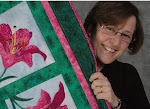



I love bead embroidery. This is a diagram I made to show how I sew the beads onto my quilt tops. I use nylon bead thread like Nymo D, in colours to match the bead colour. The quilt in the last post was beaded using this method.
I also make beaded bugs to add as appliques after completing the quilts. The Beetle/Dragonfly photo shows bugs made with pre-printed fabric that a student gave me. The first photos show bugs that I drew from photographs then beaded. I traced the drawings onto cotton then coloured it with permanent markers. I basted a piece of stabilizer onto the back. I beaded the edges and outlined areas. I filled in the spaces with more beads. Then I glued satin fabric onto the backs and trimmed the edges.
The beaded bugs make a great focal point for garden and landscape wall quilts. Two books that I highly recommend: Bead Creative Art Quilts by Nancy Eha and The Beading Buddy by Mary Stori.



No comments:
Post a Comment